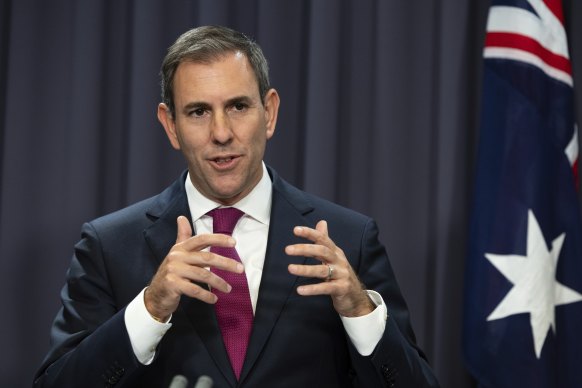
Save articles for later
Add articles to your saved list and come back to them any time.
Getting workers enough hours and helping people who have given up on finding a job back into the workforce will be key to the federal government’s employment plan in the wake of its jobs and skills summit last year.
Having revealed the first budget surplus in 15 years on Friday, Treasurer Jim Chalmers will on Monday release the employment white paper, centred around the government’s own definition of full employment, which could help it navigate the uncomfortable fact that the country has a better-than-full employment rate under the technical definition.
Treasurer Jim Chalmers said the government has its own definition of full employment.Credit: Alex Ellinghausen
Australia’s unemployment rate is currently 3.7 per cent, close to the near 50-year lows it first reached in July last year. But on a technical definition of full employment, it would have to rise to about 4.5 per cent to be at a level that does not cause inflation to increase.
Chalmers on Friday reconciled having a technical definition of full employment – called the non-accelerating inflation rate of unemployment, or NAIRU – alongside the government’s own goals when it comes to bolstering the Australian workforce.
“It’s possible to have a narrow, technical assumption about full employment which feeds the forecasts of the Reserve Bank and the Treasury and others,” he said. “But what I’ve tried to do is to say that that is very different from the government’s objective, the government’s aspiration.
“Our government’s objective is a good, secure fairly paid job for everyone who wants one without looking for too long. That’s our objective. And that’s what the white paper is built on.”
Extracts from the white paper released by the government on Friday evening said Labor’s proposed definition was a “broader and longer-term objective” than the current technical definition.
“An estimate of the NAIRU … does not capture the full extent of spare capacity in our economy or the full potential of our workforce,” the white paper said.
That spare capacity includes the 2.8 million people who are not working the number of hours they would like or need to work, and those who were previously unemployed but had given up looking for a job.
“For every person in Australia reported in the labour force statistics as unemployed, there are four others who want to work but are not actively searching or available to work, or who want to work more hours,” the white paper said.
Chalmers said it was about creating a dynamic, and a more inclusive labour market, but also about strengthening the economy.
“Obviously, in order to lift living standards and to get wages moving in a responsible and sustainable way, we need to make our economy more productive, more dynamic, more competitive,” he said.
The treasurer on Friday unveiled the first federal government surplus in 15 years, which he said was a result of saving higher-than-expected tax revenue, spending restraint, and savings.
The final budget figures showed $13.2 billion in additional tax receipts helped boost the budget bottom line.
The majority of that – $12.7 billion – was from a higher corporate tax take, thanks to higher prices for resources such as iron ore. Those prices have been driven up as the war in Ukraine disrupted (and continues to disrupt) supplies of commodities.
Another factor that helped was that government payments were $4 billion less in 2022-23 than originally expected, and that was largely due to lower-than-expected demand for COVID-related products and services.
That included spending $700 million less than expected on Medicare Benefits Scheme services such as COVID-related pathology, and $500 million less on PBS products driven by a lower uptake in COVID-19 vaccines.
Finance Minister Katy Gallagher said the federal government also found $40 billion in savings over its first two budgets, including $7 billion in the 2022-23 financial year, which has helped the bottom line.
Shadow treasurer Angus Taylor said the surplus had been delivered off the back of strong commodity prices and it was unclear if Labor could repeat the feat in its next budget.
“This surplus was largely driven by soaring commodity prices and higher tax receipts from Australians working harder for less to keep up with skyrocketing bills and prices under Labor,” he said.
Cut through the noise of federal politics with news, views and expert analysis from Jacqueline Maley. Subscribers can sign up to our weekly Inside Politics newsletter here.
Most Viewed in Politics
From our partners
Source: Read Full Article
